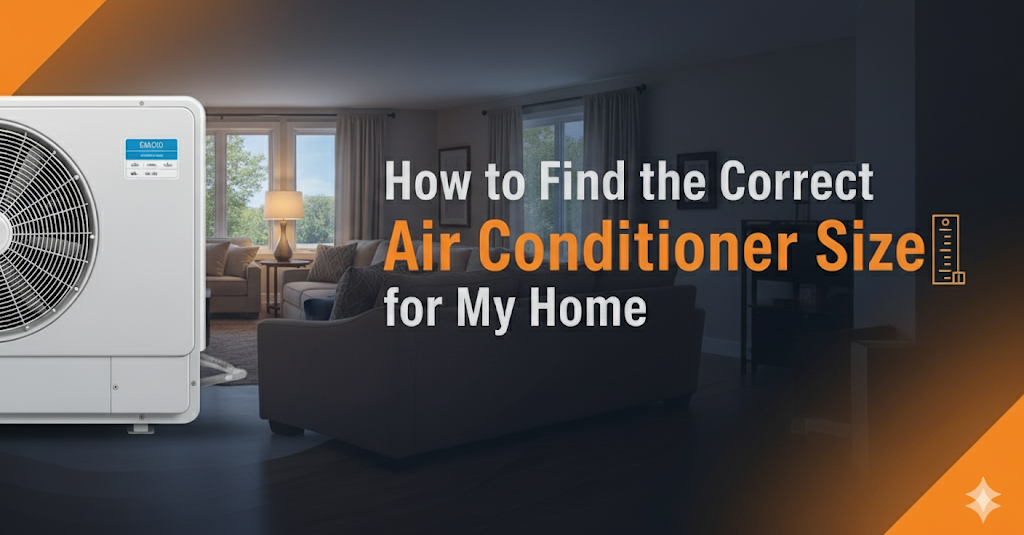Introduction
When summer heat strikes, one of the most common concerns Canadian homeowners have is: how to find the correct air conditioner size for my home? Getting this decision right is essential—not just for comfort, but also for efficiency and cost savings.
An undersized AC will struggle to cool your home, running nonstop and driving up energy bills. On the other hand, an oversized unit will cool too quickly without properly dehumidifying the air, leading to uneven comfort and higher wear and tear.
This detailed guide from GM Heating & Cooling Inc. explains everything you need to know, including BTUs, SEER ratings, room-based sizing, Canadian rebates, and when to call a professional.
Understanding the Basics:
To answer how to find the correct air conditioner size for my home, you first need to know two key terms:
- BTU (British Thermal Unit): A measure of cooling capacity. More BTUs = more cooling power.
- SEER (Seasonal Energy Efficiency Ratio): A rating that shows efficiency. A higher SEER means your AC uses less energy for the same cooling.
For Canadian homes, the right mix of BTU and SEER ensures comfort while keeping electricity bills under control.
Why Choosing the Right AC Size Matters:
Finding the correct AC size isn’t just about comfort—it affects your wallet and system lifespan.
- Efficiency: A well-sized AC cools without wasting energy.
- Longevity: Reduces stress on the unit, extending its life.
- Lower Bills: Balanced cooling = less electricity usage.
- Even Comfort: Prevents hot or cold spots.
An incorrectly sized system can mean higher repair costs, discomfort, and more frequent breakdowns.
Factors Affecting
When determining how to find the correct air conditioner size for my home, consider:
- Square Footage: Larger homes = higher BTUs needed.
- Insulation Quality: Better insulation reduces BTU needs.
- Occupancy: More people generate more heat.
- Appliances: Electronics, ovens, and lights add extra heat load.
- Canadian Climate: Ontario summers need stronger cooling than coastal regions.
- Ceiling Height: Taller ceilings require more cooling capacity.
How to Calculate the Correct Air Conditioner Size for My Home in Canada
Here’s a general square footage-to-BTU chart:
| Home Size (Square Feet) | Recommended AC Size (BTUs) |
|---|---|
| 600 – 1,000 sq. ft. | 18,000 – 21,000 BTUs |
| 1,000 – 1,500 sq. ft. | 21,000 – 24,000 BTUs |
| 1,500 – 2,000 sq. ft. | 24,000 – 30,000 BTUs |
| 2,000 – 2,500 sq. ft. | 30,000 – 34,000 BTUs |
| 2,500 – 3,000 sq. ft. | 34,000 – 42,000 BTUs |
⚡ Tip: Use this as a guide. For accuracy, GM Heating & Cooling Inc. offers Manual J load calculations tailored to your home.
How to Find the Correct Air Conditioner Size for My Home by Room Type
If you only need AC for certain rooms, use this chart:
| Room Type | Room Size (sq. ft.) | Recommended AC Size (BTUs) |
|---|---|---|
| Bedroom | 100 – 400 | 5,000 – 9,000 BTUs |
| Living Room | 400 – 600 | 10,000 – 12,000 BTUs |
| Kitchen | 300 – 500 | 7,000 – 10,000 BTUs |
| Basement | 500 – 1,000 | 12,000 – 18,000 BTUs |
| Whole Apartment | 600 – 1,200 | 18,000 – 24,000 BTUs |
This breakdown makes it easier to target the correct air conditioner size for my home when cooling single areas.
Government Rebates and Incentives in Canada:
Canadians can save money while upgrading their cooling system. When exploring how to find the correct air conditioner size for my home, keep these programs in mind:
- Canada Greener Homes Grant – Rebates for energy-efficient installations.
- Provincial Rebates – Ontario, BC, and Alberta offer additional rebates.
- Energy Star® Benefits – Energy-efficient AC units may qualify for incentives.
Correct sizing ensures your AC meets rebate requirements while keeping utility bills lower.
Professional Help from GM Heating & Cooling Inc:
Charts and calculators help, but nothing compares to a professional assessment. GM Heating & Cooling Inc. provides precise Manual J Load Calculations that consider:
- Your home’s square footage
- Windows and insulation quality
- Appliance heat load
- Local Canadian climate patterns
This ensures your air conditioner is perfectly matched to your home’s needs—saving you money, preventing breakdowns, and maximizing comfort.
Conclusion
The right air conditioner size is the foundation of comfort, efficiency, and savings. Whether you’re cooling a small condo in Toronto or a large house in Vancouver, the main question remains: how to find the correct air conditioner size for my home?
By considering BTUs, SEER ratings, insulation, and climate, you can make an informed choice. For the most reliable results, trust the experts at GM Heating & Cooling Inc. to size and install your AC properly, ensuring long-term comfort.
FAQs
1. What happens if my AC is too small for my home?
It will run constantly without fully cooling your home, increasing energy bills and wear on the system.
2. Is a bigger air conditioner always better?
No. An oversized AC cools too quickly, leaving humidity in the air and causing uneven comfort.
3. How do I calculate AC size myself?
Use square footage-to-BTU charts as a guideline, but for accuracy, a professional load calculation is best.
4. What’s the best AC size for a 2,000 sq. ft. home in Canada?
Typically, 24,000–30,000 BTUs, depending on insulation, climate, and ceiling height.
5. Can I qualify for rebates with a new AC in Canada?
Yes. Choosing the correct size and Energy Star® rated unit often qualifies you for federal or provincial incentives.


